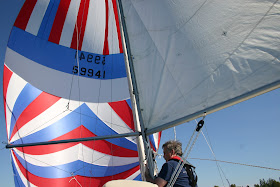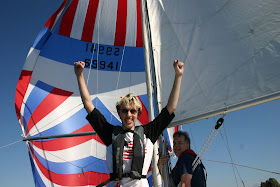
|
| Our first time flying the spinnaker. |
It has been Sandi's goal for quite some time that we would fly our symmetrical spinnaker on July 4th, Independence Day, of this year, for reasons that should be apparent from the accompanying pictures. It was looking like we were not going to get all the rigging in place until after the 4th, but everything came together and it worked.
This is a fairly big deal for us, because nobody on board has ever flown a spinnaker. All knowledge has been acquired by reading articles and books, and viewing videos online. (Possibly the best video on using the spinnaker is this one, Spinnaker Sailing, on YouTube.) We knew that there is some knowledge that you only get from actually doing something, so we were not sure that we even would make it work.
While still at dock, we checked our rigging and re-tensioned some stays. Also, a cleat had been moved for us on the dock to allow better tying up, so we adjusted our dock lines.
Before heading out, we planned on putting the spinnaker out on the port side. We planned that we would not bring out the jib until we were done with the spinnaker. So we fastened the turtle (spinnaker bag) to the life line on that side. We attached the snapshackles to the tack and clew of the spinnaker. Fortunately the port and starboard corners of the spinnaker are color coded.
For this season we are using the jib halyard to raise the spinnaker. For next season, we will probably add a head to the mast that has a separate ring and block just for the spinnaker. We have a furling jib, so the jib halyard is unused otherwise. We fastened the jib halyard to the top of the spinnaker sock. We tucked the jib sheets around the forward cleats so that they'd be low and out of the way.
We left the dock and motored out. We dropped the swing keel and raised the mainsail. Then we brought out the spinnaker pole and attached it to the mast ring. We attached the topping lift to the top of the spinnaker pole and the downhaul to the bottom and ran the port spinnaker sheet through the end of the spinnaker pole.

|
| Spinnaker wrapped around the jib. |
We then got ready and tried raising the spinnaker sock. First try failed as one of the lines was on the wrong side of the downhaul. Second try found another line interfering and had to be adjusted. Third try also failed, as we had failed to put the starboard spinnaker sheet around the front of the jib. Fourth try got the spinnaker sock to the top of the mast. The sock was lifted and the spinnaker started flying. There was not enough tension on the sheets though, and the spinnaker promptly wrapped itself around the jib! How do you solve that?
Turns out that if the slack is taken in on the sheets, and the helm varies a little off the wind, that enough wind catches the spinnaker to cause it to unwrap itself. And suddenly the spinnaker filled and was out flying! A little adjusting the sheets and downhaul and off we went, flying south down Lake Washington. The captain had to adjust to the fact that we had both the mainsail and spinnaker flying, but she soon figured that out.

|
| Success! |
Our spinnaker is red, white, and blue, which in the U.S. is very patriotic. We had people in power boats going by and blasting their horn!
After a very fast run down the lake toward Kirkland, we took down the spinnaker. Not completely without problems. The spinnaker sock did not want to come down. After a little head scratching, we figured out the problem: the sock lifting line was still cleated. You can pull on the line to bring it down as hard as you can and it will not budge when the lifting line is cleated!
The sock came down. Then the spinnaker came down and was folded back into the turtle. Unfastened the sheets and halyard, took it off the lifelines and down the forward hatch. The sheets and halyard get clipped to rings and stays to keep them from flopping around. We unfastened the spinnaker pole from the topping lift, downhaul, and mast ring, and stowed it below. Then we were ready to bring out the jib and tack back up the lake.
However, when the spinnaker wrapped itself around the jib, it messed up the furling of the jib and practically tied the jib sheets into knots. It took us a while to get that straightened out. After tacking back up, we pulled into the dock, exhausted but feeling very satisfied that all this work has paid off.